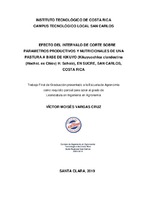| dc.description.abstract | The effect of the cut interval (harvest frequency), on productive parameters and nutritional value of a pasture based on kikuyo (Kikuyuochloa clandestina (Hochst. ex Chiov) H. Scholz) was evaluated; the study was carried out in the La Bretañita farm, located in the Quesada district, specifically in the town of Sucre in the canton of San Carlos, Costa Rica. The study consisted of four treatments (cutting intervals): T1 = 30 days, T2 = 40 days, T3 = 50 days and T4 = 60 days. The treatments were randomly distributed in five blocks. The response variables were content (%) and dry matter production (DM) (kg ha-1, kg ha-1 cut-1 and kg ha-1 year-1). The nutritional value characteristics evaluated were crude protein content (PC%), neutral detergent fiber (FDN%), detergent acid fiber (FAD%), ethereal extract (EE%), ashes (%) and lignin (%). At the beginning and end of the trial the botanical composition was evaluated and the change in the proportion of the different categories of vegetation in the plots was determined. The DM contents were similar between treatments although at 30 days of interval between cuts, the highest value was obtained (18.9%, P<0.05). The production of DM tended to increase as the intervals between cuts were higher. With the exception of the 50-day treatment, the lowest production, both growth rate and production per cut, were lower (P<0.05) at 30 days between cuts. The estimated productions ha-1 year-1 were 19.8 and 24.5 t DM, for 30 and 60 days, respectively. There was a reduction in nutritional value, PC content fell from 22.4 to 20.0% (P<0.05), while FND and FAD content rose slightly from 61.1 to 62.0 (P>0.05) and from 29.7 to 31.5% (P<0.05), respectively. The contents of ethereal extract and ashes were not altered (P>0.05), while there was an increase (P<0.05) in the level of lignin by increasing the interval between cuts. The main change in botanical composition occurred in the 30-day interval between cut treatment, where the proportion of kikuyo decreased by 13 percentage points with an increase in the African star proprition. According to the previous results, it is suggested
XV
that under the farm conditions in which kikuyo pastures are handled in cutting and hauling systems, harvest intervals between 40 and 60 days are allowed since changes in both yield and yield Nutritive value are not markedly different in this range. It is clear from this study that kikuyo grass does not show severe reductions in nutritional value due to age, as would be expected in other tropical species. | es |


